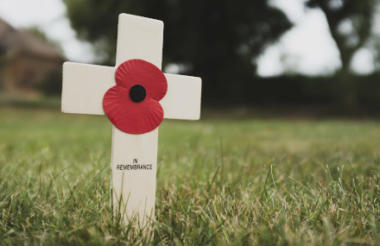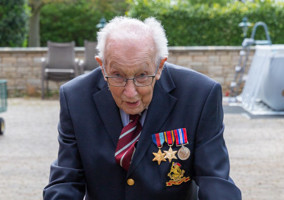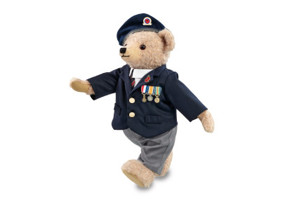Red Poppy – The Royal British Legion
The Royal British Legion (RBL) Poppy Appeal celebrates its 100th anniversary this year. The emblematic flower became the inspiration for the RBL campaign when thousands of red poppies grew amidst the desolation and destruction of the Western Front. Ever since, the poppy has become a symbol of remembrance and hope which commemorates those who fought in the British Armed Forces.
The Poppy Appeal has become so synonymous with the RBL that the flower features in its logo.
Each year the Poppy Appeal raises approximately £50m for the charity, which is a large share of its income. However, most of the donations for the appeal are collected in cash - meaning government restrictions in 2020 prevented the selling of poppies and drastically affected the amount of donations. But this year, with most restrictions lifted, RBL is expecting more cash donations to be made.
The money raised provides support to the Armed Forces community through financial, employment, housing, rehabilitation and mental health support for veterans and their families.
Red poppies cost between £2 - £10.
Today is #Cardiff Poppy Day! We have lots going on to mark our centenary year, so please do come down to show your support for this very special #PoppyAppeal #RBL100 #EveryPoppyCounts pic.twitter.com/3sqYBUXPQf
— Royal British Legion (@PoppyLegion) November 9, 2021
White Poppy – Peace Pledge Union
In 1933, the Co-operative Women's Guild produced the first white poppies which symbolise pacificism. The Guild were “worried by the growing militarisation of Remembrance events and the detachment between the red poppy and the need to work for peace”.
White poppies are now produced by campaign group Peace Pledge Union. Controversy has arisen surrounding the RBL’s Poppy Appeal, with some deeming it a glorification of war and conflict. As an alternative, PPU sells white poppies which “represent remembrance for all victims of war, a commitment to peace and a challenge to attempts to glamorise or celebrate war”.
Green Party leader and MP Caroline Lucas was seen wearing a white poppy with a red one on Question Time last week.
In 2018, first aid charity St Johns Ambulance allowed its volunteers to wear the white pacifist poppy for the first time.
The money raised is used by the campaign group to continue challenging militarism and championing non-violent protests against war.
White poppies are sold in packs of five for £5.
Whatever your plans this morning, please remember to pause at 11am for a 2-minute silence in remembrance of all victims of war
— Peace Pledge Union (@PPUtoday) November 11, 2021
both civilian and military
of all nationalities
both in the past and today#RememberThemAll #WhitePoppies pic.twitter.com/mPaTMgSSWo
Purple Poppy – War Horse Memorial & animal charities
Purple poppies are worn to honour animals who were victims of war. Many war horses, dogs and pigeons were killed during service in WW1.
The Animal Purple Poppy Appeal is organised by War Horse Memorial, which donates the money raised to various animal charities. Their charity partners include, but are not limited to:
• Household Cavalry Foundation
• Mane Chance Sanctuary
• The Horse Trust
• World Horse Welfare
Susan Osborne, director of communications at War Horse Memorial, told Civil Society News: “As a community interest company (CIC) with no salaries to pay for we can be flexible in our fund-raising approaches, and the way we operate is that sales from purple poppy activity supports our chosen animal charities and horse sanctuaries and other fundraising we do helps our military charities. These organisations ask us for help and we do our best to fundraise for specific requests i.e pieces of equipment.”
Osborne noted that “this last month we have never been busier” and the charity is receiving as many as 500 orders a day.
“We believe this is because the pandemic and subsequent lockdowns have made people re-connect with their pets and animals, and in doing so made them appreciate the service and sacrifice of animals in war.”
The Purple Poppy Appeal uses the Poppy trademark under license from the Royal British Legion, but is not affiliated to the RBL’s campaign.
Purple poppies are sold for £3.
Please support our Animal Purple Poppy Fund launch to help animals in desperate need. Buy your pin badge from our official shop here https://t.co/CGN76KPKaX #warhorsememorial #animalpurplepoppyfund #horses #mules #donkeys #animalwelfare pic.twitter.com/Mi1SCsVRJm
— War Horse Memorial (@supportwarhorse) June 8, 2021
Black Poppy – BlackPoppyRose
BlackPoppyRose was created in 2010 by Selena Carty. It is worn to represent the contributions made by Black, African, Caribbean and Pacific Islands communities in war.
According to the website, BlackPoppyRose “fully supports the legacy of the red poppy, however, felt that as a member of the African/Black/West Indian/Pacific Island communities it was important to highlight our contribution to world history”.
BlackPoppyRose host events dedicated to remembering Black communities that were victims of wars from the Maroon Wars to the Korean War.
The organisation also stressed the symbol is necessary because “in a country that many African/Black/West Indian/Pacific Island people call home, the history that represents us has been displaced over the course of time”.
The money raised goes towards BlackPoppyRose's mission to educate their followers of Black history, and the sacrifices that were made by many Black, African, Caribbean and Pacific Islands communities during war.
Black poppies cost between £1.50 - £6.
Get your pins today
— BlackPoppyRose (@Blackpoppyrose) October 28, 2021
We are opening new conversations, new narratives and new methods around empowering global healing.
Order yours https://t.co/O1XS1zwRXp pic.twitter.com/mapi0s2k8P
Gold & Silver Poppies – The Royal British Legion
This year, Royal British Legion has created a bespoke poppy pin in honour of Captain Sir Tom Moore. The new poppy has 100 laser ridged edges to celebrate Sir Tom’s 100 years, his 100 laps and 100 years of the RBL, which is one of the charities that The Captain Tom Foundation supports. The centre of the new poppy is a gemstone and each pin is engraved with ‘Captain Sir Tom Moore, 1920 – 2021’ to commemorate his legacy.
All of the profits from the pins go to RBL and supporting the Armed Forces Community. The design has been approved by both The Captain Tom Foundation and the veteran’s family.
Hannah Ingram-Moore, Captain Tom's daughter, told RBL: “My father was passionate about the wonderful work of the Royal British Legion, so to have his own Captain Sir Tom Moore poppy pin to help raise funds and awareness for their cause would have been a dream come true.”
The pins are available in gold or silver, and are priced at £29.99.
‘Tomorrow will be a good day’ are the words spoken by the late Captain Sir Tom Moore that inspired 1000s to take on new challenges and raised spirits globally. Pay tribute to the @BritishArmy Veteran we all grew to love with our new commemorative poppy. ➡️ https://t.co/2Nw9Sfu7P5 pic.twitter.com/5UbQr0KyDx
— Royal British Legion (@PoppyLegion) October 11, 2021
Related articles












